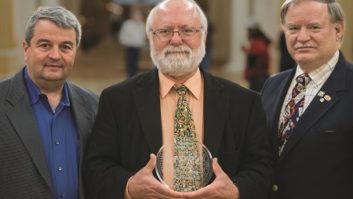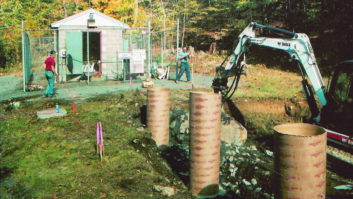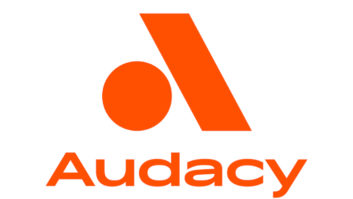
Shown: A Wheatstone E-6 surface, RCS NexGen Digital software, Telos VX phone system, EV mics and Blue Sky EXO2 speakers. Twenty-three Wheatstone M-2 microphone processors serve 46 microphones in the facility. Some studio moves happen quickly. Others, like the recent relocation of Clear Channel’s seven-station cluster in Portland, Ore., are years in the making.
“We were supposed to make the move back in 2008,” says Chris Weiss, the cluster’s director of engineering, “but we had trouble finding a new location.”
That’s an understatement, really. After struggling to find a site that met all of the stations’ needs, Clear Channel ended up signing a lease, only to find out that its new landlord itself hadn’t closed on its purchase of the building. What’s more, the new location turned out to be a haz-mat site, further entangling the stations in legal battles that forced Clear Channel to extend the lease on its existing studios in the meantime.
It took several years for the lawyers to clear the way for a second attempt at a move, and Weiss says it all came together much more quickly this time.
SPACE EFFICIENCIES
Clear Channel’s new home is in the top two stories of a four-story building in an office park in the Portland suburb of Tigard.
“We negotiated the lease in January of 2012, so it was a pretty quick turnaround of things, from saying yes, for sure we’re doing this, to getting in here with hard hats,” Weiss recalls of his busy year, which culminated in mid-October with the move of the last two stations from Clear Channel’s old facility just south of downtown Portland along the Willamette River.
At about 25,000 square feet, the new facility is about the same overall size as the old plant, but Weiss says the move allowed for much more efficient use of the space. Clear Channel’s old studios had been in use since 1978, when they were built for KEX(AM) and sister station KKRZ(FM). Over the years, another AM station and two more FMs were jammed into that two-story space, while two more sister FMs set up shop in an adjacent building.
“We had a lot of hallways and stairwells,” Weiss recalls of the old facility.

In the technical operations center, each airchain has its own rack, with a Wheatstone IP-88AD Blade serving each primary chain and Aura8-IPs for backup. The racks include main and backup Arbitron PPM encoding, AirTools profanity delay, audio server and streaming audio server. About midway down the row is a rack of Sage Alerting Systems EAS Endecs. By contrast, the new facility was designed from the ground up for all seven stations at once. Studios for all the stations are located on the third floor, where top-40 KKRZ (“Z100”) looks into the lobby and its six sisters are all lined up along an interior corridor.
“We don’t have any studios on external windows,” Weiss says, “which turns out to be a big cost savings, since we didn’t have to triple-glaze or quadruple-glaze.”
WHEATSTONE NETWORK
In addition to physical proximity, the new studios improved on the old ones in another way. Because of the changing equipment needs in 21st century radio, Weiss was able to make some of the new studios smaller than their equivalents at the old buildings.
“We’ve saved about 350 square feet from the studio that used to house the full-service AM station (KEX), since you don’t need two tape decks and an overbridge anymore,” Weiss says.
Instead, the new studios were built on two models: each of the five FM music stations has a similar studio with four mics and a Wheatstone E-4 or E-6 control surface, while each of the two AM talk stations has a control room equipped with an E-6 and a talk studio with a Wheatstone SideBoard controller, as well as an adjacent production studio that can also serve as a news or sports booth.
Five production rooms for the cluster each use Wheatstone IP-12 consoles. The total complement of Wheatstone gear includes 13 control surfaces, 56 WheatNet-IP Blades, 23 mic processors, and numerous panels, turrets and support gear.
Weiss says the choice of Wheatstone was one of the biggest decisions during the project. At the old Macadam Avenue studios, Clear Channel’s stations had used a variety of consoles. Weiss says recent experience persuaded him that his new facility would use some flavor of audio over IP technology.
“I’d been trying to prepare and figure out a routing system for Portland going back to 2005, figuring we’d be going into a move,” Weiss recalls. “When Clear Channel in Seattle went Wheatstone, my regional manager, Erik Kuhlmann, suggested I take a look at it.” He was particularly impressed with redundancies built into the WheatNet-IP system.
BUILDING WITH HEADLAMPS
The studios all use ElectroVoice RE20 and RE27 mics, a choice driven by the ability to move some mics over from the old studios. Beyond the mics, everything was new, including Studio Technology furniture, Blue Sky EXO2 speakers, RCS NexGen Digital automation and a Telos VX phone system.


Architects Luckett & Farley have worked with Clear Channel on numerous studio projects. The facility occupies space on two floors. (Photos by Dan Trypak, Vancouver, Wash.)
Weiss says the phone system turned out to be one of the learning experiences from the move; each VX Engine can handle 30 audio streams at once (caller audio, mix-minus back to the caller and/or music on hold), which proved to be not quite enough for seven stations running at full tilt, especially when KEX moved over with its news people.
Adding a second engine so that the AM stations could have their own system solved the problem, and Weiss says it has proved to be a worthy replacement for the Telos 2101s at the old facility.
The furniture involved another construction adventure. When the building contractor failed to deliver power to the studios on schedule, Weiss says Vince Fiola’s Studio Technology crew went to work anyway. “His guys ended up having to install all the furniture with no power in the studio. They did it with headlamps and those portable construction lights,” Weiss says, but it got finished on time.
Architects Luckett & Farley, who have worked with Clear Channel on numerous studio projects in recent years, placed the stations’ tech core on the fourth floor, which also houses a conference room that doubles as a live performance studio and a large walk-out patio space.
In addition to a homebrew Asterisk-based phone system and common EAS gear for the entire cluster, the tech core houses individual racks for each station’s NexGen systems and Wheatstone equipment.
BACKUPS
Redundancies at the new facility extend to the transmission architecture. Each of the seven stations has two Wheatstone Blade IP access units, a main and a backup. While the main Blade usually feeds a fiber distribution system, the backup Blade automatically connects to the backup microwave system, ensuring continuity even should the entire system break down.
In normal operation, Clear Channel’s new system routes Wheatstone’s audio-over-IP over fiber all the way from the studios in Tigard to the two hilltop transmitter sites that serve the five FM stations. From there, for now, a backup path then goes by microwave to the site southeast of Portland, where the two AM stations, KEX and KPOJ, are located. That reverses the old microwave architecture, which went from Macadam Avenue out to the AM site and then hopped to the FMs from there; eventually, he’s hoping to get dark fiber all the way out to the AM site.
“When you start passing this stuff along other people’s networks, you lose the ability to do multicasting … and you introduce latencies you don’t have any control over,” he says.
Whether it’s dark or not, Weiss says he’s sold on the use of fiber for his studio-transmitter links.
“We had already been going down that road,” he says of the last few years at the old studios. Fiber serving both FM sites suffered only two outages in nearly a decade; by contrast, he says the T1 that’s fed by copper to his AM site had already suffered five outages before 2013 was even half over.
BUILDING A TEMPLATE
The move from Macadam Avenue to Clear Channel’s new home was completed over the course of several weeks in September and October 2012, with two stations moving each week. Weiss says the five FMs, which were first to move, went smoothly, with things getting more complicated at the end of the move when KEX and KPOJ and their larger staffs relocated.
But after more than 34 years at Macadam Avenue, Clear Channel cleared out with two weeks left on the lease and some help from out of town, as Milwaukee-based engineer Steve George worked with Kuhlmann to dismantle the old studios and put usable gear in storage to be shipped eventually to other Clear Channel markets.
For a company as large as Clear Channel, Weiss says the process of working with other engineers on a big move is essential. Earlier in 2012, Weiss spent a week at Clear Channel’s Sacramento cluster assisting with — and learning from — a similar move.
“Your typical market engineer might do this once in a lifetime,” Weiss says, “but what did we learn as a company in this process? If we can come up with solutions that could work for 75 percent of the company, we can build templates on those, and create standards around which we can build local options.”
Scott Fybush wrote about radio as “emergency infrastructure” in the May 22 issue.










